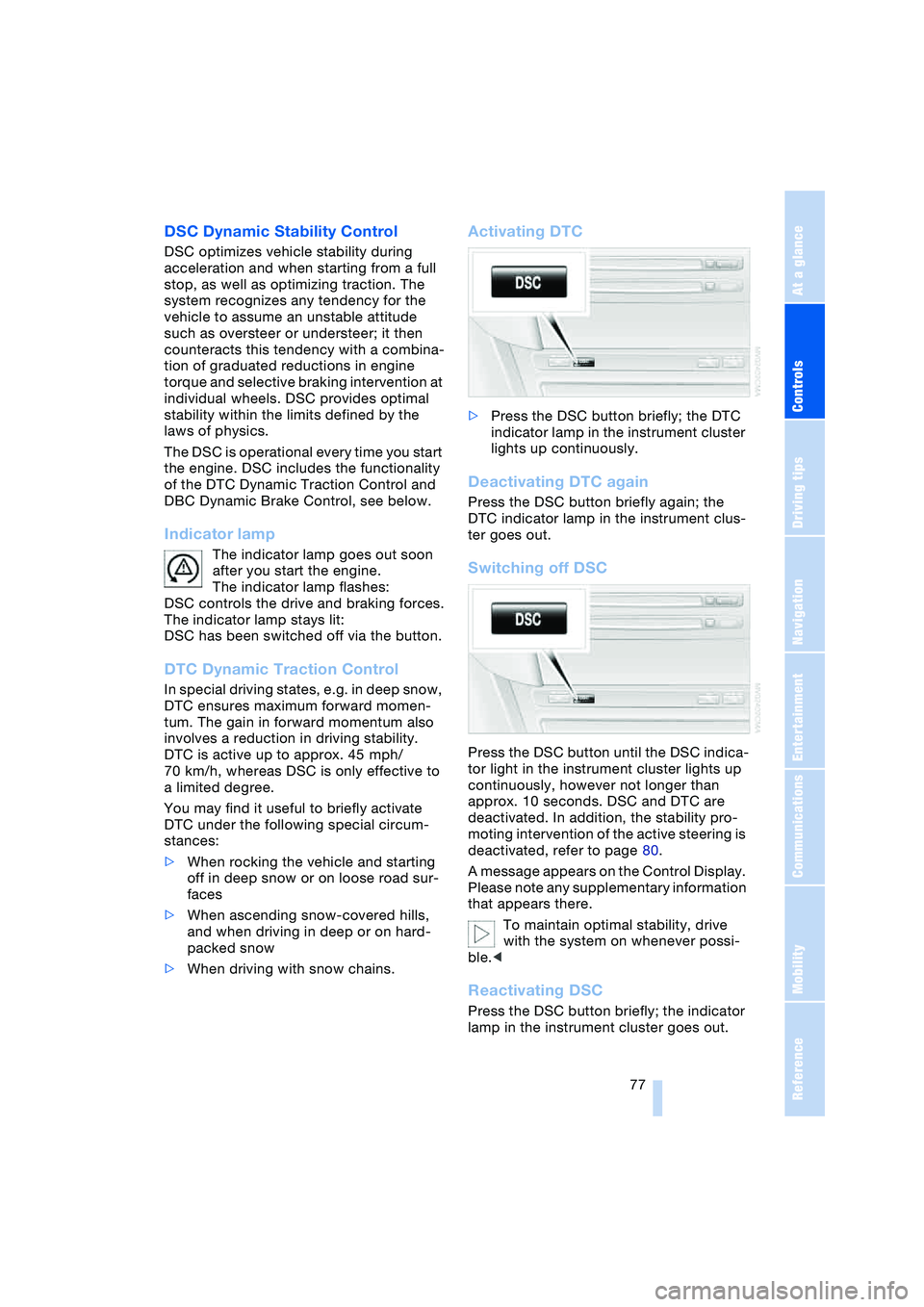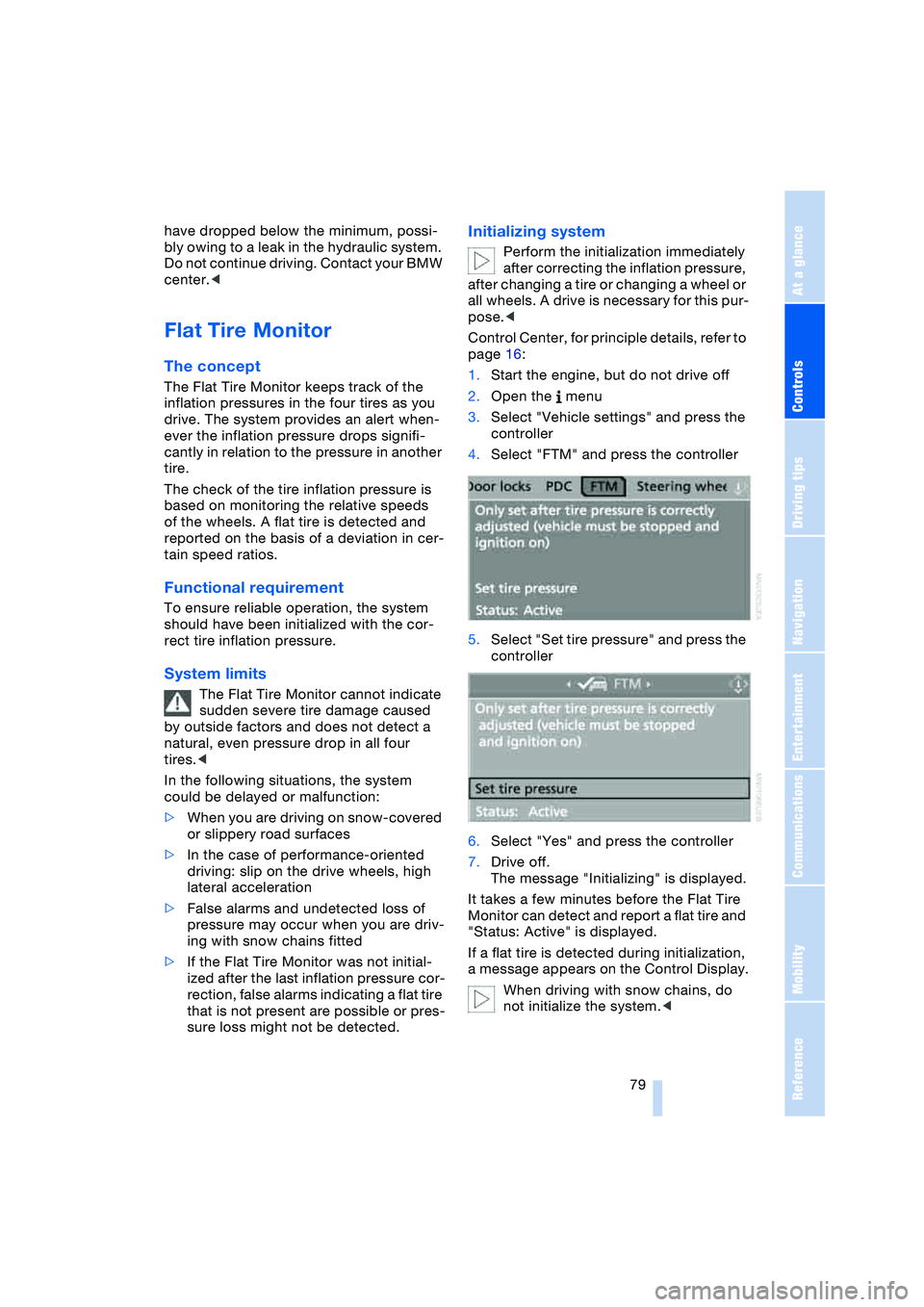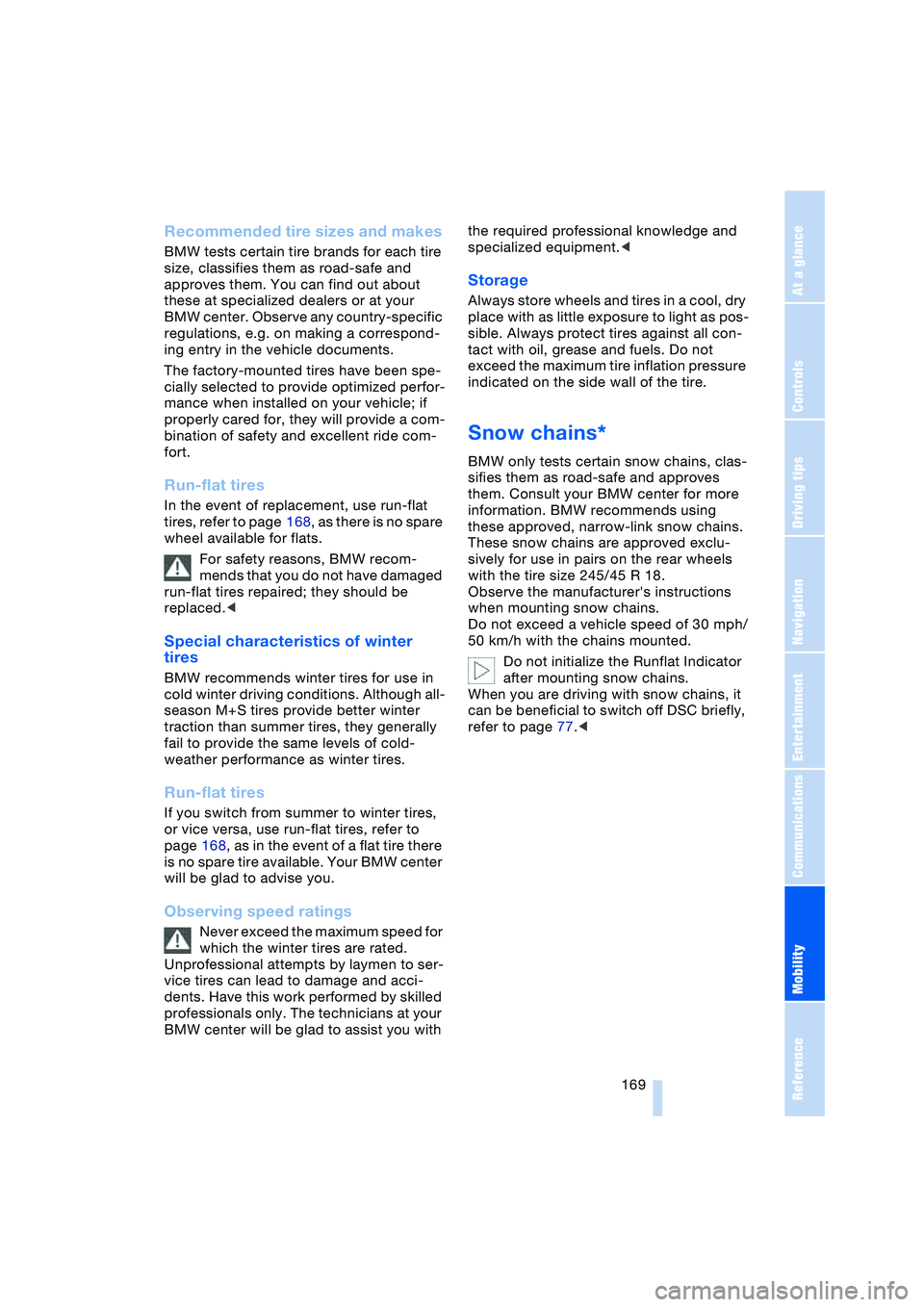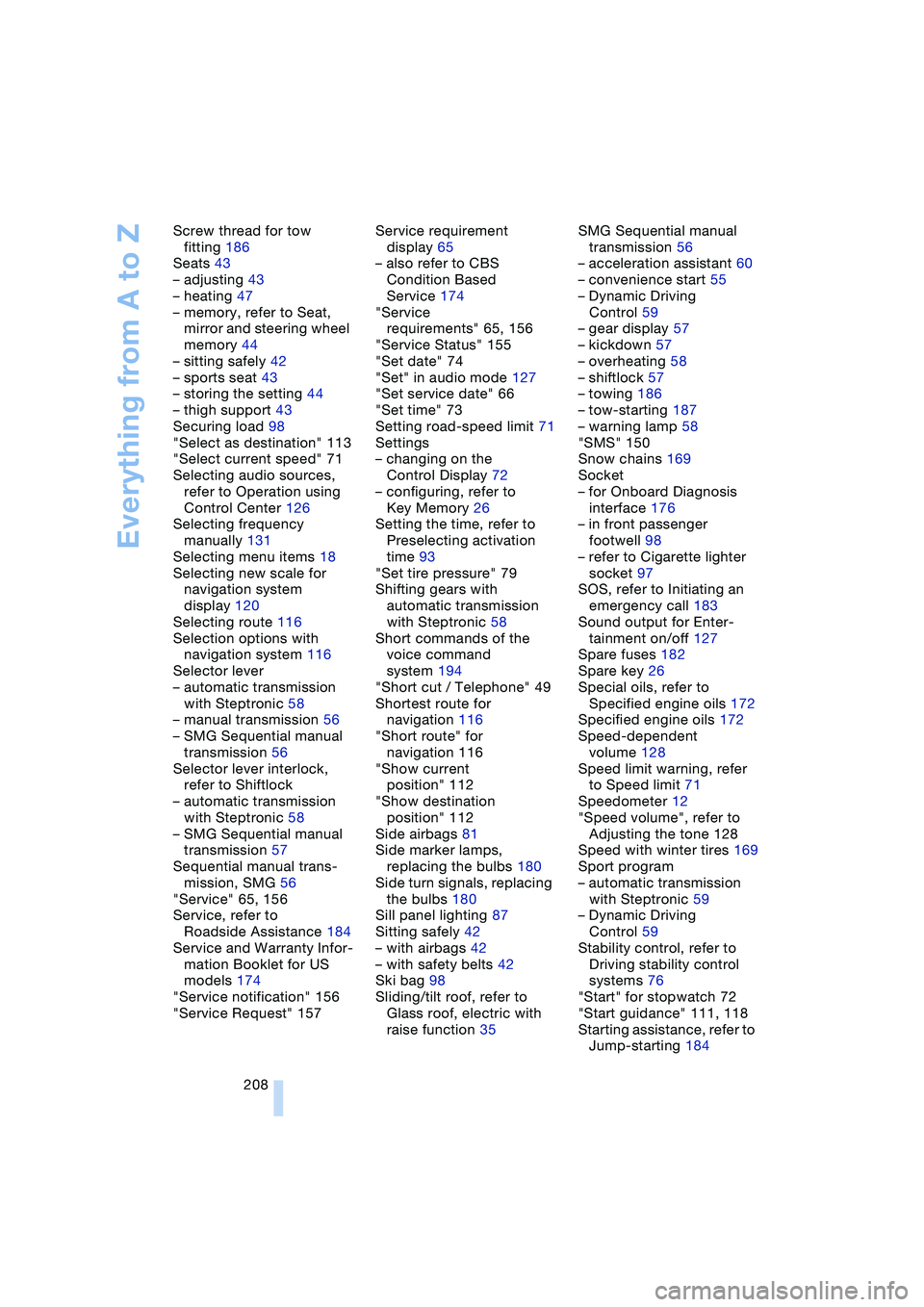2004 BMW 645CI COUPE&CONVERTIBLE snow chains
[x] Cancel search: snow chainsPage 79 of 216

Controls
77Reference
At a glance
Driving tips
Communications
Navigation
Entertainment
Mobility
DSC Dynamic Stability Control
DSC optimizes vehicle stability during
acceleration and when starting from a full
stop, as well as optimizing traction. The
system recognizes any tendency for the
vehicle to assume an unstable attitude
such as oversteer or understeer; it then
counteracts this tendency with a combina-
tion of graduated reductions in engine
torque and selective braking intervention at
individual wheels. DSC provides optimal
stability within the limits defined by the
laws of physics.
The DSC is operational every time you start
the engine. DSC includes the functionality
of the DTC Dynamic Traction Control and
DBC Dynamic Brake Control, see below.
Indicator lamp
The indicator lamp goes out soon
after you start the engine.
The indicator lamp flashes:
DSC controls the drive and braking forces.
The indicator lamp stays lit:
DSC has been switched off via the button.
DTC Dynamic Traction Control
In special driving states, e.g. in deep snow,
DTC ensures maximum forward momen-
tum. The gain in forward momentum also
involves a reduction in driving stability.
DTC is active up to approx. 45 mph/
70 km/h, whereas DSC is only effective to
a limited degree.
You may find it useful to briefly activate
DTC under the following special circum-
stances:
>When rocking the vehicle and starting
off in deep snow or on loose road sur-
faces
>When ascending snow-covered hills,
and when driving in deep or on hard-
packed snow
>When driving with snow chains.
Activating DTC
>Press the DSC button briefly; the DTC
indicator lamp in the instrument cluster
lights up continuously.
Deactivating DTC again
Press the DSC button briefly again; the
DTC indicator lamp in the instrument clus-
ter goes out.
Switching off DSC
Press the DSC button until the DSC indica-
tor light in the instrument cluster lights up
continuously, however not longer than
approx. 10 seconds. DSC and DTC are
deactivated. In addition, the stability pro-
moting intervention of the active steering is
deactivated, refer to page 80.
A message appears on the Control Display.
Please note any supplementary information
that appears there.
To maintain optimal stability, drive
with the system on whenever possi-
ble.<
Reactivating DSC
Press the DSC button briefly; the indicator
lamp in the instrument cluster goes out.
Page 81 of 216

Controls
79Reference
At a glance
Driving tips
Communications
Navigation
Entertainment
Mobility
have dropped below the minimum, possi-
bly owing to a leak in the hydraulic system.
Do not continue driving. Contact your BMW
center.<
Flat Tire Monitor
The concept
The Flat Tire Monitor keeps track of the
inflation pressures in the four tires as you
drive. The system provides an alert when-
ever the inflation pressure drops signifi-
cantly in relation to the pressure in another
tire.
The check of the tire inflation pressure is
based on monitoring the relative speeds
of the wheels. A flat tire is detected and
reported on the basis of a deviation in cer-
tain speed ratios.
Functional requirement
To ensure reliable operation, the system
should have been initialized with the cor-
rect tire inflation pressure.
System limits
The Flat Tire Monitor cannot indicate
sudden severe tire damage caused
by outside factors and does not detect a
natural, even pressure drop in all four
tires.<
In the following situations, the system
could be delayed or malfunction:
>When you are driving on snow-covered
or slippery road surfaces
>In the case of performance-oriented
driving: slip on the drive wheels, high
lateral acceleration
>False alarms and undetected loss of
pressure may occur when you are driv-
ing with snow chains fitted
>If the Flat Tire Monitor was not initial-
ized after the last inflation pressure cor-
rection, false alarms indicating a flat tire
that is not present are possible or pres-
sure loss might not be detected.
Initializing system
Perform the initialization immediately
after correcting the inflation pressure,
after changing a tire or changing a wheel or
all wheels. A drive is necessary for this pur-
pose.<
Control Center, for principle details, refer to
page 16:
1.Start the engine, but do not drive off
2.Open the menu
3.Select "Vehicle settings" and press the
controller
4.Select "FTM" and press the controller
5.Select "Set tire pressure" and press the
controller
6.Select "Yes" and press the controller
7.Drive off.
The message "Initializing" is displayed.
It takes a few minutes before the Flat Tire
Monitor can detect and report a flat tire and
"Status: Active" is displayed.
If a flat tire is detected during initialization,
a message appears on the Control Display.
When driving with snow chains, do
not initialize the system.<
Page 171 of 216

Mobility
169Reference
At a glance
Controls
Driving tips
Communications
Navigation
Entertainment
Recommended tire sizes and makes
BMW tests certain tire brands for each tire
size, classifies them as road-safe and
approves them. You can find out about
these at specialized dealers or at your
BMW center. Observe any country-specific
regulations, e.g. on making a correspond-
ing entry in the vehicle documents.
The factory-mounted tires have been spe-
cially selected to provide optimized perfor-
mance when installed on your vehicle; if
properly cared for, they will provide a com-
bination of safety and excellent ride com-
fort.
Run-flat tires
In the event of replacement, use run-flat
tires, refer to page 168, as there is no spare
wheel available for flats.
For safety reasons, BMW recom-
mends that you do not have damaged
run-flat tires repaired; they should be
replaced.<
Special characteristics of winter
tires
BMW recommends winter tires for use in
cold winter driving conditions. Although all-
season M+S tires provide better winter
traction than summer tires, they generally
fail to provide the same levels of cold-
weather performance as winter tires.
Run-flat tires
If you switch from summer to winter tires,
or vice versa, use run-flat tires, refer to
page 168, as in the event of a flat tire there
is no spare tire available. Your BMW center
will be glad to advise you.
Observing speed ratings
Never exceed the maximum speed for
which the winter tires are rated.
Unprofessional attempts by laymen to ser-
vice tires can lead to damage and acci-
dents. Have this work performed by skilled
professionals only. The technicians at your
BMW center will be glad to assist you with the required professional knowledge and
specialized equipment.<
Storage
Always store wheels and tires in a cool, dry
place with as little exposure to light as pos-
sible. Always protect tires against all con-
tact with oil, grease and fuels. Do not
exceed the maximum tire inflation pressure
indicated on the side wall of the tire.
Snow chains*
BMW only tests certain snow chains, clas-
sifies them as road-safe and approves
them. Consult your BMW center for more
information. BMW recommends using
these approved, narrow-link snow chains.
These snow chains are approved exclu-
sively for use in pairs on the rear wheels
with the tire size 245/45 R 18.
Observe the manufacturer's instructions
when mounting snow chains.
Do not exceed a vehicle speed of 30 mph/
50 km/h with the chains mounted.
Do not initialize the Runflat Indicator
after mounting snow chains.
When you are driving with snow chains, it
can be beneficial to switch off DSC briefly,
refer to page 77.<
Page 210 of 216

Everything from A to Z
208 Screw thread for tow
fitting 186
Seats 43
– adjusting 43
– heating 47
– memory, refer to Seat,
mirror and steering wheel
memory 44
– sitting safely 42
– sports seat 43
– storing the setting 44
– thigh support 43
Securing load 98
"Select as destination" 113
"Select current speed" 71
Selecting audio sources,
refer to Operation using
Control Center 126
Selecting frequency
manually 131
Selecting menu items 18
Selecting new scale for
navigation system
display 120
Selecting route 116
Selection options with
navigation system 116
Selector lever
– automatic transmission
with Steptronic 58
– manual transmission 56
– SMG Sequential manual
transmission 56
Selector lever interlock,
refer to Shiftlock
– automatic transmission
with Steptronic 58
– SMG Sequential manual
transmission 57
Sequential manual trans-
mission, SMG 56
"Service" 65, 156
Service, refer to
Roadside Assistance 184
Service and Warranty Infor-
mation Booklet for US
models 174
"Service notification" 156
"Service Request" 157Service requirement
display 65
– also refer to CBS
Condition Based
Service 174
"Service
requirements" 65, 156
"Service Status" 155
"Set date" 74
"Set" in audio mode 127
"Set service date" 66
"Set time" 73
Setting road-speed limit 71
Settings
– changing on the
Control Display 72
– configuring, refer to
Key Memory 26
Setting the time, refer to
Preselecting activation
time 93
"Set tire pressure" 79
Shifting gears with
automatic transmission
with Steptronic 58
Short commands of the
voice command
system 194
"Short cut / Telephone" 49
Shortest route for
navigation 116
"Short route" for
navigation 116
"Show current
position" 112
"Show destination
position" 112
Side airbags 81
Side marker lamps,
replacing the bulbs 180
Side turn signals, replacing
the bulbs 180
Sill panel lighting 87
Sitting safely 42
– with airbags 42
– with safety belts 42
Ski bag 98
Sliding/tilt roof, refer to
Glass roof, electric with
raise function 35SMG Sequential manual
transmission 56
– acceleration assistant 60
– convenience start 55
– Dynamic Driving
Control 59
– gear display 57
– kickdown 57
– overheating 58
– shiftlock 57
– towing 186
– tow-starting 187
– warning lamp 58
"SMS" 150
Snow chains 169
Socket
– for Onboard Diagnosis
interface 176
– in front passenger
footwell 98
– refer to Cigarette lighter
socket 97
SOS, refer to Initiating an
emergency call 183
Sound output for Enter-
tainment on/off 127
Spare fuses 182
Spare key 26
Special oils, refer to
Specified engine oils 172
Specified engine oils 172
Speed-dependent
volume 128
Speed limit warning, refer
to Speed limit 71
Speedometer 12
"Speed volume", refer to
Adjusting the tone 128
Speed with winter tires 169
Sport program
– automatic transmission
with Steptronic 59
– Dynamic Driving
Control 59
Stability control, refer to
Driving stability control
systems 76
"Start" for stopwatch 72
"Start guidance" 111, 118
Starting assistance, refer to
Jump-starting 184